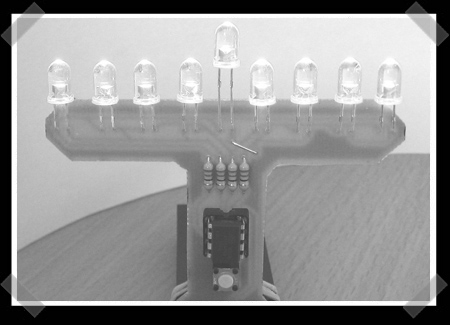Reader [Mike] was not too impressed by design in a recent post we did on an LED menorahs. Doing what any self respecting hacker would do, he designed and built a better one then sent it in to us. He just happened to have an AVR ATtiny13 sitting around, so he used that for the brains. It has single button operation, is powered by 2 AA batteries, and even simulates the candles burning out. His custom PCB turned out quite nicely as well, the power plug connects to the batteries in a way that uses them as a base. Check out his site for detailed plans and source code. Great job [Mike].
classic hacks2791 Articles
Pringles Can Macro Photography

Reader [Harald] sent us this sweet Pringles can macro photography hack from way back in 2005. Using a Pringles can and a standard Cannon 50mm MKII lens, they have produced some amazing results. The image above is the tip of a ballpoint pen. Not only does he go through the steps to make it, but then goes in depth on how to best set your camera and other good practices for macro photography. Pringles cans aren’t just for holding chips and making wireless antenna.
We’ve covered several macro photography rigs before, like how to do macro photography with your iPhone, or with a flip camera, and even how to build a massive laser controlled macro photography setup.
Super Nintendo Clock

[Aaron] sent us this sweet Super Nintendo Clock that he built. When he found himself with a broken SNES, a friend challenged him to out do his previous NES clock. This time, the display would be located in the cartridge, and removable. Setting the time is done on the SNES controller and seems to work pretty well as you can see in the video after the break.
WaldFlöte: Midi Controlled Pipe Organ
Members of Dorkbot Edinburgh have done what most of us would do if we had a 19th century pipe organ. They hacked it to be midi controlled. The organ is located above a cafe owned by the university of Edinburgh. Students have been repairing and modifying it to get it back in working order.
The electronics are composed of an Xilinx Spartan-3E Starter Kit as the brains and a Microblaze processor converting midi events for the solenoids. The cool thing is that none of this required any permanent modification to the organ itself. It can all be removed to put the organ back in normal playing condition. Check out the video after the break for some classical Van Halen.
Functional Etch A Sketch Costume

We love all of the creative Halloween costumes that have started trickling in now that the holiday is finally over, and people have found time to document their last minute projects. Take this functional Etch A Sketch costume made by [mazinbenny]. The knobs are lawnmower wheels. The pulley system is strung with 1/16″ wire rope to move a carrier for a dry erase marker. The marker draws directly on an acrylic screen. HowStuffWorks has a post on how a real aluminum powder based Etch A Sketch works.
We’ve covered more technical Etch A Sketch projects in the past. We’ve seen them hooked up to computer mice, drawing portraits at Maker Faire, and commenters have even suggested turning mechanical dry erase boards into giant Etch A Sketches.
Adjustable Breadboard Power Supply

This looks like a great addition to your breadboard. [Nerdz] wanted a power supply that was easily portable and adjustable. He built a custom board that plugs directly into the breadboard’s power rails. It has a pot attached to the ground of a 7805 voltage regulator so the output can be adjusted from 5V to just under the supply voltage. Anything that makes a breadboard less of a rats nest is definitely a good thing.
Arduino RC Airplane

[Olivier] told us about this fantastic project where he built his own RC airplane. The airplane itself is nothing special, it is the controls that are worth paying attention to. He used an Arduino Diecemilla , some XBee transceivers, and a SparkFun Wee. The main site is a general overview, but there are links to more detailed breakdowns of how to build some of the parts. There are several videos of him flying it as well.











